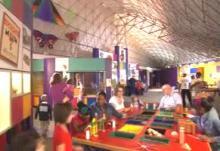
The National Museum of Play is one of America’s largest history museums and the nation’s second largest children's museum.1 With a vast collection of dolls, toys, and games, it is dedicated to exploring “play and the ways in which it encourages learning, creativity, and discovery and illuminates cultural history.” The museum also seeks to communicate the “critical role of play in human physical, social, and intellectual development.”2
The National Museum of Play traces its beginnings to 1968. Margaret Woodbury Strong had spent a lifetime collecting dolls and toys in her Rochester, New York home. She created the Margaret Woodbury Strong Museum of Fascination, so named by her guests after their tours of her collections.3 She hoped her museum would “fascinate, educate, and entertain.”4
Thirteen years after her death the Margaret Woodbury Strong Museum opened in downtown Rochester on 13.5 acres of land. The initial focus of the museum was concerning industrialization and how it affected everyday life. During the 1970s and 1980s other focus points were the “consequences of progress, the rise of the middle class, and the expressions of identity.”5
With the desire to shift their focus to attract families, in 1997, the original 156,000 square foot museum received a new glass atrium entrance in order to house an operating 1918 carousel and a 1950s diner. The museum displays were also becoming more interactive and child oriented as well.
In 2002, the museum had the opportunity to acquire the National Toy Hall of Fame from A.C. Gilbert's Discovery Village in Salem, Oregon. The National Toy Hall of Fame annually recognizes toys which have been popular over several generations and thereby have become a significant part of the American culture. This was the first of many major additions to the museum’s collections.
In 2006, a physical expansion of adding 126,000 square feet to the museum added amenities, such as museum shops and a food court, and also greatly increased the museum’s capacity for interactive displays. With hundreds of thousands of play items in the collection, a new collection storage facility was also added.
By 2010, the expanded museum complex was renamed The Strong. As one of the five Play Partners within The Strong, the Strong National Museum of Play became known as the National Museum of Play.
What commenced as Margaret's extensive private collection of dolls and toys has expanded over several decades to include hands-on exhibits, educational programs, an indoor Dancing Wings Butterfly Garden, the Strong Express passenger train, an outdoor Discovery Garden, a life-size pop-up book in Reading Adventureland, a 1700 gallon coral reef aquarium, and the role-playing world of American Comic Book Heroes.6
Besides the interactive adventures, the National Museum of Play has a 15,000 doll collection, a 7,500 diverse game collection, a 68,000 piece toy collection, 6 different toy manufacturer collections including Playskool and Fisher-Price, and 10 other play-related collections, such as the Berenstain Bears Collection and a Souvenir and Postcard Collection.7 Tens of thousands of play-related items can be accessed online along with the museum’s Play Stuff blog.
Other Play Partners housed at The Strong include the National Toy Hall of Fame, the International Center for the History of Electronic Games, the Brian Sutton-Smith Library and Archives of Play, and the American Journal of Play.
- 1. “Margaret Woodbury Strong.” The Strong. < http://www.thestrong.org/about-us/margaret-woodbury-strong > 4 April. 2011.
- 2. “Mission.” The Strong. < http://www.thestrong.org/about-us/mission > 4 April 2011.
- 3. Op. cit., “Margaret Woodbury Strong.”
- 4. “About Us.” The Strong. < http://www.thestrong.org/about-us > 4 April 2011.
- 5. “History.” The Strong. < http://www.thestrong.org/about-us-history > 4 April 2011.
- 6. “Things to See & Do.” National Museum of Play. < http://www.museumofplay.org/see-do > 5 April 2011.
- 7. National Museum of Play. < http://www.museumofplay.org > 5 April. 2011.

